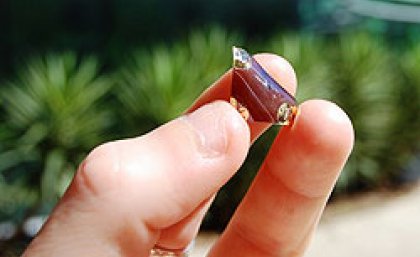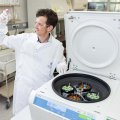
UQ research has discovered how to create a whole new array of plastics with metallic or even superconducting properties.
The research has been published in the journal ChemPhysChem by a team led by UQ's Professor Paul Meredith and Associate Professor Ben Powell, and Associate Professor Adam Micolich from the University of New South Wales. This latest discovery reports experiments by recent UQ PhD graduate Dr Andrew Stephenson.
The technique involves placing a very thin layer of metal onto a plastic sheet and mixing it into the polymer surface with an ion beam, with strong, flexible and conductive plastic film the result.
Ion beam techniques are widely used in the microelectronics industry, but attempts to adapt this process to plastic films have been made since the 1980s with only limited success – until now.
"What the team has been able to do here is use an ion beam to tune the properties of a plastic film so that it conducts electricity like the metals used in the electrical wires themselves, and even to act as a superconductor and pass electric current without resistance if cooled to low enough temperature," Professor Meredith said.
To demonstrate a potential application for the material, the team produced electrical resistance thermometers. Tested against an industry standard platinum resistance thermometer, it had comparable or even superior accuracy.
"This material is so interesting because we can take all the desirable aspects of polymers – such as mechanical flexibility, robustness and low cost – and add good electrical conductivity, something not normally associated with plastics," Dr Micolich said.
Dr Stephenson said the most exciting part about the discovery is how precisely the film's ability to conduct or resist the flow of electrical current can be tuned, opening up a broad potential for useful applications.
"In theory, we can make plastics that conduct no electricity at all or as well as metals do, and everything in between," he said.
As well as being inexpensive, flexible and easy to produce, these new materials are vastly more tolerant of exposure to oxygen compared to standard semiconducting polymers.
Combined, these advantages may give the new material a bright future in the ongoing development of plastic electronics applications.
More information: The paper, "A Tunable Metal-Organic Resistance Thermometer", by Stephenson et al., was published in the January edition of ChemPhysChem. DOI: 10.1002/cphc.201000762.
Media: Dr Andrew Stephenson (07 3346 7964, a.stephenson@uq.edu.au) or
Aarti Kapoor from the School of Mathematics and Physics (07 3346 9935, a.kapoor@uq.edu.au)



